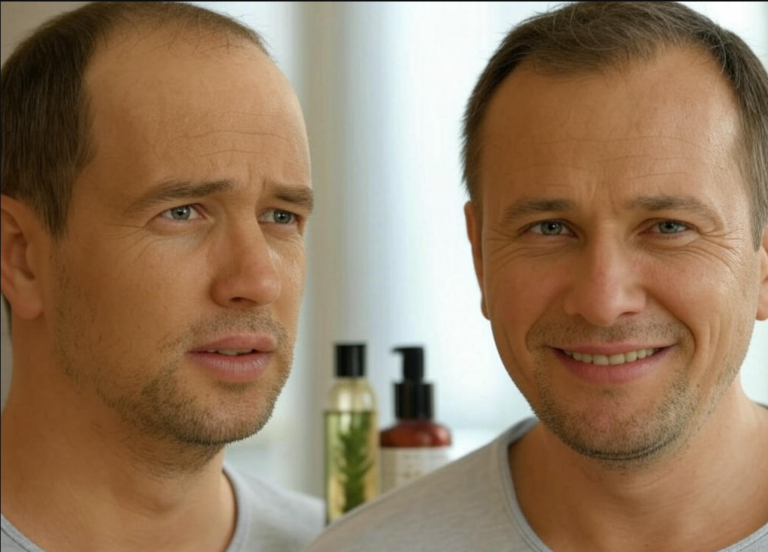
Hair loss affects millions of people worldwide, with up to 50% of men experiencing some degree of it before they turn 50. But this isn’t just a “man’s problem.” Hair loss impacts women and individuals from all walks of life, often causing frustration and diminishing self-esteem.
This guide will walk you through the causes of hair loss, the available treatments, and preventative tips to help you manage and restore your hair health. If you’re struggling with thinning hair or a receding hairline, keep reading to learn practical and effective solutions that suit your needs.
What Is a Receding Hairline?
A receding hairline refers to the gradual thinning of hair at the front of the scalp, often forming an “M” shape in men. While women typically experience diffuse thinning across the scalp, they may also notice frontal hair loss, commonly linked to conditions like frontal fibrosing alopecia.
The Stages of Receding Hairlines
Hair loss progresses through stages, especially in men, where it’s measured using the Norwood Scale.
- Stage 1 & 2: Slight thinning near the temples or a subtle change in hairline shape.
- Stage 3: The “M” shape becomes pronounced, with deeper temple recessions.
- Stage 4 & 5: Bald spots start emerging at the crown, connecting with front hair loss.
- Stage 6 & 7: Significant or near-total baldness remains, leaving hair only at the sides.
For women, the Ludwig Scale measures patterns of thinning, often starting at the part line and worsening over time.
Causes of Hair Loss
Understanding why you’re losing hair is the first step to finding the right solution.
Hereditary Factors
Male and female-pattern baldness, or androgenic alopecia, is the most common cause of hair loss. This genetic condition makes hair follicles shrink over time due to increased sensitivity to dihydrotestosterone (DHT), a hormone linked to hair thinning.
Hormonal Changes
Hormonal imbalances, especially during pregnancy, menopause, or puberty, can trigger excessive shedding or thinning hair.
Aging
Hair growth naturally slows, and hair follicles weaken as we age, contributing to thinner and shorter strands over time.
Stress and Lifestyle
Chronic stress, poor sleep, and unhealthy habits can throw your body (and your hair follicles) into disarray. Stress-related hair loss, or telogen effluvium, is often temporary but noticeable.
Medical Conditions and Medications
Issues like alopecia areata (an autoimmune disorder), hypothyroidism, and chemotherapy treatments can lead to temporary or permanent hair loss.
Diagnosing Hair Loss
Professional assessment is critical to understanding your hair loss. Here are a few common methods your dermatologist might use to pinpoint the cause:
- Physical Exam: A thorough check of scalp health and hair condition.
- Blood Tests: Used to detect thyroid issues or nutrient deficiencies that can affect hair growth.
- Pull Test: Gently pulling several hairs to measure shedding severity.
- Scalp Biopsy: Examining hair follicles for infections or other conditions.
- Light Microscopy: Analyzing hair shafts to identify structural abnormalities.
Effective Hair Loss Treatments
Luckily, there’s no shortage of treatment options for those dealing with hair loss. Here are some of the most effective methods to consider.
FDA-Approved Medications
- Minoxidil (Rogaine)
A topical solution that helps stimulate new hair growth and slow down loss. Minoxidil is available over the counter and is suitable for both men and women.
- Finasteride (Propecia)
A prescribed oral medication that reduces DHT levels, slowing the progression of hair loss in men.
Low-Level Laser Therapy (LLLT)
This non-invasive treatment uses light to stimulate hair follicles, promoting regrowth. Laser caps and devices are available for at-home use.
Hair Transplant Surgery
For severe cases, hair transplant techniques like Follicular Unit Extraction (FUE) can restore hair permanently by transferring healthy follicles to thinning or balding areas.
Platelet-Rich Plasma (PRP) Therapy
PRP involves injecting your own plasma into your scalp to promote hair growth. It’s particularly effective when started early.
Prevention and Management Tips
While not all hair loss can be reversed, taking preventative steps can slow its progression and keep your hair healthier.
1. Early Intervention Matters
The earlier you address hair loss, the better your chances of regrowing hair or preventing further thinning. Don’t wait too long to discuss symptoms with a professional.
2. Lifestyle Changes
- Balanced Diet: Ensure your meals include iron, biotin, zinc, and protein, which are vital for healthy hair.
- Manage Stress: Practice yoga, meditation, or other relaxation techniques to minimize stress-related hair loss.
- Stay Hydrated: Drinking enough water supports a healthy scalp, which is essential for strong hair.
3. Gentle Hair Care
- Use a sulfate-free shampoo to avoid stripping natural oils.
- Protect your hair from sun exposure with hats or UV-protectant sprays.
- Avoid heat styling tools and minimize how often you dye or chemically treat your hair.
4. Massage Your Scalp
A simple 5-minute scalp massage daily increases blood flow, stimulating hair follicles for healthier growth.
Mental Health Matters
For many, hair loss is more than a physical issue; it’s an emotional one. Losing hair can impact confidence, identity, and mental health. Here are ways to keep your perspective positive:
- Therapy: If hair loss is affecting your mental well-being, speaking with a counselor can help build a positive self-image.
- Support Groups: Connect with others experiencing similar struggles for advice and encouragement.
- New Styles: Many find empowerment in a bold buzz cut or shaved head look. Finding a style that suits you is key to feeling confident.
Natural Remedies and Alternatives
Prefer a more natural approach? While results may vary, the following options are worth trying alongside other treatments:
- Essential Oils: Rosemary and peppermint oils may improve blood circulation to the scalp.
- Herbal Supplements: Saw palmetto and ginseng are believed to have hair-strengthening properties.
- DIY Hair Masks: Egg yolk, honey, and olive oil mixtures can nourish and strengthen weak hair strands.
Hair loss can be distressing, but it’s not a road you have to travel alone. Whether you’re looking for medical treatments, preventative measures, or new ways to care for your hair, there’s a solution to suit your needs. Taking early action and incorporating a combination of treatments can yield the best results.
Remember, confidence isn’t about how much hair you have. It’s about how you carry yourself! If you’re still unsure about the best treatment for your specific situation, consider consulting a hair loss specialist to create a personalized plan.







